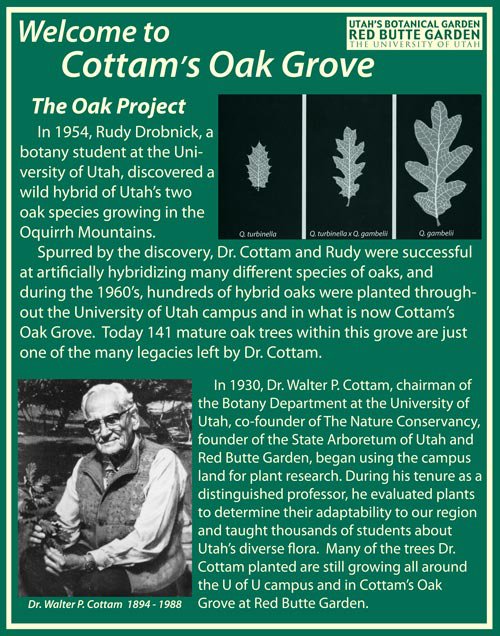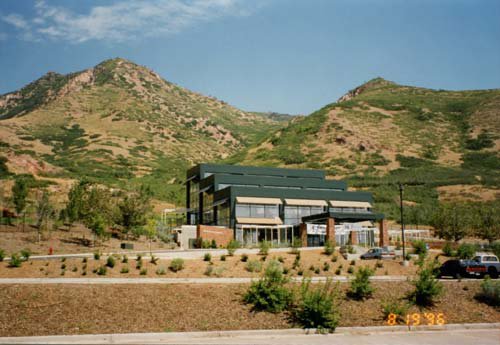
Week One - 35 Years of Growing
Submitted: Nov. 27, 2020, 3:36 p.m.
Red Butte Garden formally opened to the public in 1985, but its roots go even deeper than 35 years.

Dr. Walter Cottam, founding father of the State Arboretum of Utah (painted portrait by Alvin Gittins)
The Garden's story begins with Dr. Walter P. Cottam.
In 1930, Dr. Walter P. Cottam, co-founder of The Nature Conservancy and chairman of the Botany Department at the University of Utah began collecting and planting native plants in what became known as Cottam’s Gulch at a site near President’s Circle. Additionally, he proceeded to spend the next 30 years planting new and unusual trees throughout campus. Dr. Cottam was the first person in the nation to cross two species of oak from two different classes. Many of the tree species from his original study are still alive today in an area west of our Amphitheatre that we affectionately call Cottam’s Grove.
In 1961, the Utah State Legislature formally recognized Cottam's impressive collection by designating the University's campus landscape, including the future Red Butte Garden area, as the State Arboretum. The original legislation mandated that the Arboretum "provide resources and facilities for cultivating a greater knowledge and public appreciation for the trees and plants around us, as well as those growing in remote sections of the country and world."

Cottam's Grove
Dr. Cottam was the first person in the nation to cross two species of oak from two different classes. Many of the tree species from his original study are still alive today in an area west of our Amphitheatre that we affectionately call Cottam’s Grove.

The bronze Oak Leaf sculpture created by Willy Littig in 1994, symbolizes Cottam’s oak hybridization research.
Today, the Garden’s horticulture staff maintain the collection of trees and collect the acorns each season to fulfill requests for these hybrids from other gardens and researchers from around the globe.

Early days of Red Butte Garden
As the University grew, so did the Arboretum's need for permanent public educational facilities and display gardens. In 1983, Ezekiel R. Dumke. Jr. and Richard Hildreth led the charge to have the University dedicate 100 acres at the mouth of Red Butte Canyon for a regional botanical garden. The organization's name was changed from the State Arboretum to Red Butte Garden & Arboretum. The site provided an outstanding opportunity to showcase horticultural collections and to interpret the richly diverse natural area. This opportunity inspired the expansion of the Garden's mission to include not only horticulture but also conservation and environmental education.

Red Butte Garden Visitor Center, 1996
The Garden formally opened to the public in 1985. In 1994, the Walter P. Cottam Visitor Center (funded by the George S. and Dolores Dore Eccles Foundation) opened. Over the years other additions have been the Hemingway Four Seasons Garden, Fragrance Garden, Medicinal Garden, Herb Garden, Dumke Floral Walk, Children’s Garden, the Richard K. Hemingway Orangerie, an amphitheatre, gift shop, the McCarthy Family Rose Garden, and the Water Conservation Garden.

Red Butte Garden Visitor Center, 2020
Today, Red Butte Garden has 21 acres of display gardens, natural areas, and over five miles of hiking trails. The Garden has grown into one of the nation’s pre-eminent botanic gardens with 250,000+ annual visitors, over 14,000 members, and 300 active volunteers. The Garden is renowned for its award-winning gardens, numerous plant collections, including its springtime display of over 560,000 blooming bulbs, outdoor concert series, and award-winning educational programs. It has become a place where people seek horticultural knowledge, family programming, volunteering, or a stunning natural setting for weddings and special events.
For more Garden history, check out Red Butte Garden's Fall 2018 magazine article written by Derrek Hanson, Red Butte Garden's current executive director.